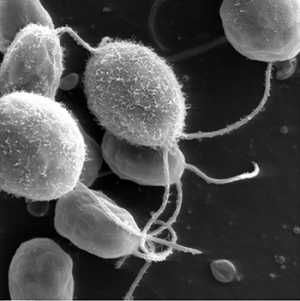2007, DOI: 10.1128/EC.00064-07
Proposed carbon dioxide concentrating mechanism in Chlamydomonas reinhardtii
Abstract
 Aquatic photosynthetic microorganisms account for almost 50% of the world’s photosynthesis. These organisms face several challenges in acquiring CO2 from the environment. The first challenge is presented by the properties of ribulose bisphosphate carboxylase-oxygenase (Rubisco). Rubisco is an unusually slow enzyme with a low affinity for CO2. At atmospheric levels of CO2, Rubisco can function at only about 25% of its catalytic capacity because the concentration of dissolved CO2 is less than the Km(CO2) of Rubisco and due to the relatively high concentration of O2 which competes with CO2. A second challenge these organisms face is that the diffusion of CO2 in an aqueous solution is 10,000 times slower than the diffusion of CO2 in air. Thus, the ability to scavenge CO2 as quickly as it becomes available is highly advantageous to aquatic photosynthetic organisms. Third, algae often experience significant fluctuations in inorganic carbon (Ci = CO2 + HCO3−) levels and pH, which change the availability of CO2 and HCO3− for photosynthesis. At an acidic pH, the vast majority of Ci is in the form of CO2, while at an alkaline pH, Ci is mostly in the form of HCO3−, with CO2 making up only a small fraction of the available Ci
Aquatic photosynthetic microorganisms account for almost 50% of the world’s photosynthesis. These organisms face several challenges in acquiring CO2 from the environment. The first challenge is presented by the properties of ribulose bisphosphate carboxylase-oxygenase (Rubisco). Rubisco is an unusually slow enzyme with a low affinity for CO2. At atmospheric levels of CO2, Rubisco can function at only about 25% of its catalytic capacity because the concentration of dissolved CO2 is less than the Km(CO2) of Rubisco and due to the relatively high concentration of O2 which competes with CO2. A second challenge these organisms face is that the diffusion of CO2 in an aqueous solution is 10,000 times slower than the diffusion of CO2 in air. Thus, the ability to scavenge CO2 as quickly as it becomes available is highly advantageous to aquatic photosynthetic organisms. Third, algae often experience significant fluctuations in inorganic carbon (Ci = CO2 + HCO3−) levels and pH, which change the availability of CO2 and HCO3− for photosynthesis. At an acidic pH, the vast majority of Ci is in the form of CO2, while at an alkaline pH, Ci is mostly in the form of HCO3−, with CO2 making up only a small fraction of the available Ci
